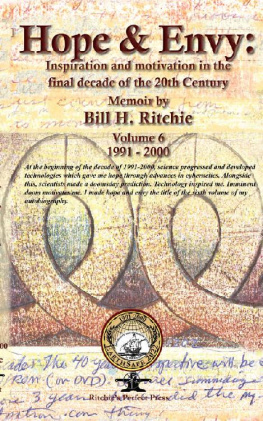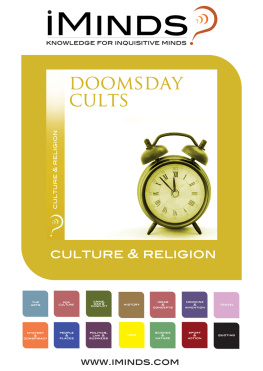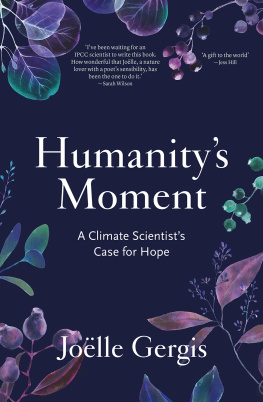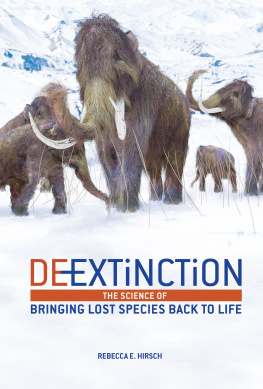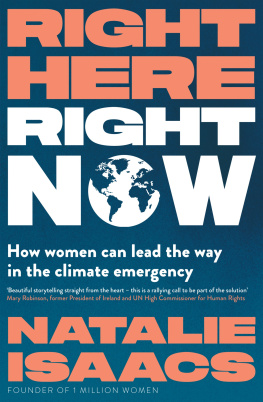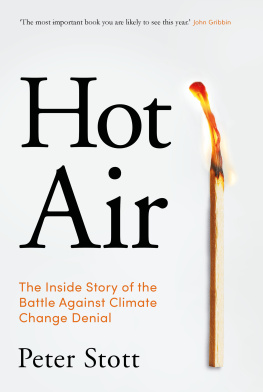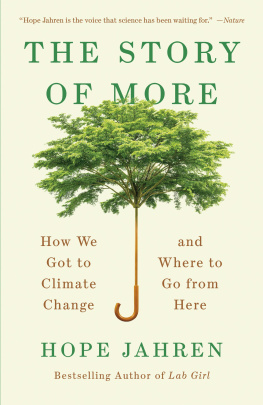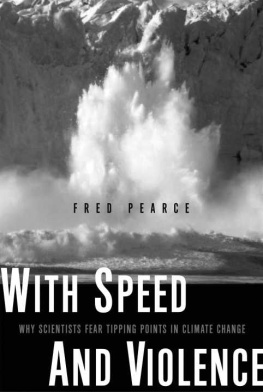Hope & Envy:
Inspiration and motivation
in the final decade of the
th Century
Memoir by Bill H. Ritchie
1991 2000
Hope and Envy:
Inspiration and motivation in the final decade
of the 20 th Century
By Bill H. Ritchie
Bill H. Ritchies Autobiography
Volume 6 1991 - 2000
The decade of EarthSafe 2022
Copyright 2018 Bill H. Ritchie
Third Draft
ISBN: 9781792845604
Ritchies Perfect Press
500 Aloha St. #105
Seattle WA 98109
Disclaimer
I risked self-publishing this version in both paper and Kindle eBook despite errors, omissions, improper punctuation and sentence structure. Where names of people are included, I did my best to spell them correctly. Where there is repetition of text or images, I am sorting these out. Where the text is too long or confusing, Im rewriting it to make it leaner and a better reading.
This volume, completed at the end of December 2018, is to be both a paperback and eBook in the Kindle format. The paperback must be black-white-due to the cost, but the Kindle gives readers full color throughout. Kindle is compatible with desktop and Android devices plus, of course, Amazons Fire.
Acknowledgments
The following is a partial list of individuals whose names are mentioned in this volume.
Ron Adams, Dr. Steven Albright, Lois Allan, Glen Alps, Stan Baber, Bob Bale, Feliks Banel, Bret Battey, Aaron Bennett, Jennifer Bennett, Mike Bennett, Sam Bennett, Ken Berry, Ralph Berry, Phil Bivins, Greg Both, Geoffrey Bowman, Billie Jane Bryan, Matilda Bryan, David Bull, Mike Bunney, Bobbie Butler, Margie Byers, Laura Carty, Alice Chew, Carl Chew, Carmine Chickadel, Dale Chihuly, Paula Cipolla, Joe Clark, John Cogley, Kevin Collette, Sheila Coppola, Sam Davidson, Jennie Davis, Winfred Davis, Dr. Jay Decker, Dan Diamond, Sean Elwood, Dennis Evans, Erin Fanning, Suzanne Sequoia Ferrell, Mary Flynn-Gilles, Anne Focke, Gail Frailey, Megan Gaiser, Booth Gardner, Jessica Garrick, Joseph Goldberg, Barbara Gorrell, Maria Luigia Guaita, Spence Guerin, Richard Gurtiza, Helen Gurvich, Max Gurvich, Karen Guzak, Anne Hauberg, Stephen Hazel, Spike Henderson, Tom Holder, Dr. Holl, David Hon, Frank Horton, Ed Humphries, Ron Hundley, Margaret Jacobi, Anne Johnson, Faye Jones, Phyllis Jordan, Matthew Kangas, Charles Krafft, Izumi Kuroiwa, Akira Kurosaki, Carolyn Law, Fulgencio Lazo, Kate Leonard, Mark Leonard, Dr. Leonie, Lucy Liu, Tom Lopez, Christine Loucks, David Mahler, Sherry Markovitz, Dennis Mashek, Eleanor Mathews, Nancy Mee, Robert Moawad, Barbara Mooradian, Barry Moser, Ken O'Connell, Nam June Paik, Lane Parks, Laura Perry, Mary Anne Peters, Sarah Petrie, Cheryl Phillips, Peggy Pomeroy, Vince Porteus, Ed Praczukowski, Kathy Rabel, Reino Randall, Lynda Ritchie, Rita Robillard, Stephen Rock, Steven Rock, Koryn Rolstad, Suzanne Ropiequet, Jane Sallis, Lisel Salzer, Norie Sato, Jake Schlumpf, Margaret Shannon, Alvy Ray Smith, Daniel Smith, Presha Sparling-Beckley, Constance Speth, Sarah Spurgeon, Carol Staley, Rick Stubblebine, Nellie Sunderland, Sergei Tschernisch, Brian Wallace, Molly Wankel, Elaine Wenzel, Clara Weyerhaeuser, Erica Williams, George Woodall, Bette Worley, Stevan Worley, Min Yee, Carl Youngman, and Arne Zaslove.
About the title
The combination of hope and envy is the seat of an artists survival. They are the paired inspiration and motivation sourced in the nucleus accumbens. This coffee-bean-sized are of my brain plays a central role in the reward circuit. Its operation is based chiefly on two essential neurotransmitters: dopamine, which promotes desire, and serotonin, whose effects include satiety and inhibition according to Wikipedia.
There is a nucleus accumbens in each hemisphere of my brain situated between the caudate and putamen. I think of it as the seat of artistic inspiration (the right hemisphere) and motivation (the left side). If I am inspired to make art, craft or a design, I may be on a quest for innovation. Motivated to satisfy my desire, I utilize logical plans that are most likely to succeed in realizing my dreams. The two sides are a complementary pair.
At the beginning of the decade of 1991-2000, science progressed and developed technologies which gave me hope through advances in cybernetics. Alongside this, scientists made a doomsday prediction. Technology inspired me. Imminent doom motivates me. I made hope and envy the title of the sixth volume of my autobiography.
1991
By December 24 of this year
I will be fifty years old
Artistamp based on silver point
drawing by Bill Ritchie.
Silverpoint CD/ROM
I began this volume in my autobiography with my artistamp. Its based on a drawing I made in 1991 with a fine silver wire, mounted in a crude holder. This act gave me pleasure because, for one thing, this method of drawing predates the invention of the graphite and the lead pencil.
I like silverpoint because it is tediously slow and, being so slow, it tended to make me render small drawings. Building up a solid tone takes a long time. The silver wire must be sharpened with a fine-tooth file if one wants sharp, fine lines. Leonardo Da Vincis silverpoint drawing are renowned - but hes not the only artist to use it. All artists have drawn with various chalks and charcoal from time immemorial, and Renaissance artists work includes silverpoint.

Left, Wavy Square with Target Heart , drawing.
Right: CD/ROM Target Heart , drawing.
Other metals work, too, if they are soft; but silver is the favorite of most artists. When first drawn, the lines have a cool tone. As the drawing ages over time, the silver oxidizes and becomes a warmer tone. I think artists who use silverpoint need a patient temperament. In my drawing pictured above and for this years first page as an artistamp, I was continuing my target-in-the-water theme. This drawing is an exception as the target became a CD/ROM, which was a new technology in the 1980s. I hoped it might become my platform for a new kind of studio, a perfect studio-on-a-CD/ROM.
Although I didnt know it, the Internet would soon make my CD/ROM obsolete. The Advanced Research Projects Agency Network , ARPANET, had adopted a kind of universal, shared language and protocol, TCP/IP back in 1983, and from that time researchers began to assemble the network of networks that became the modern Internet. Two scientists, Tim Berners-Lee and Robert Cailliau , had invented the World Wide Web in 1989. They wrote the first web browser in 1990 (released it this year for research institutions starting in January) and, eight months later, to the general public on the Internet in August, 1991.
Management by Goals
When I resigned from the UW School Of Art six years ago, by default I was enrolled in the school of hard knocks - just like my former students when they graduated from school with little else but a diploma. In a sense for me the school of hard knocks was a remedial college education I called Real World U . It has no curriculum plan, no syllabus and no credit. Like a wandering pilgrim, I was in a no-mans land being no longer a respected college professor and not yet a known, full-time artist like my students.
To make matters more complicated, I would be emerging as a member of the Digital Immigrants Generation . That is, I was born too soon to become skilled either in writing code or in computer science and not young enough to start over. I would have to scramble to make the most of the multimedia skills Id learned and taught before leaving the UW.
Next page
